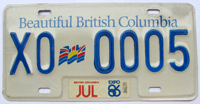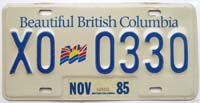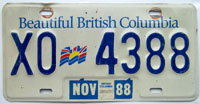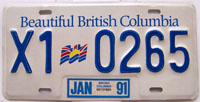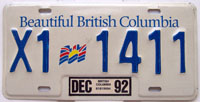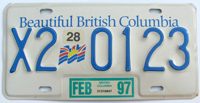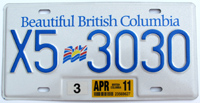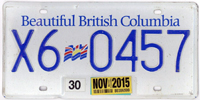|
British Columbia Industrial Vehicle (Section 7) License Plates |
||||||||||||||||||||||||||||||||||||||||||||||||||||||||||||||||||||||||||||||||||||||||||||||||||||||||||||||||||||||||||||||||||||||||||||||||||||||||||||||||||||||||||||||||||||||||||||||||||||||||||||||||||||||||||||||||||||||||||||||||||||||||||||||||||||||||||||||||||||||||||||||||||||||||||||||||
The
Insurance Corporation of British Columbia may, in respect
of any motor vehicle known or described as a tractor, grader,
loader, shovel, roller, mixer, crane or other self propelled
construction machinery used in performing work in or on a
mine or industrial undertaking, cause a licence to be issued
permitting the operation of the motor vehicle for the purpose
of proceeding to or returning from the work without load,
and the form of the licence must be varied accordingly. |
Industrial
Vehicle license plates are generally associated with heavy
machinery, such as the types quoted in the Motor Vehicle Act
above. First appearing on B.C. roads in 1957, these plates
are easily identifiable by their "X" prefix. |
| 1957 - 1963 | ||||||||||||||||||||
1-digit
|
2-digit
|
 |
|
|||||||||||||||||
1-digit
|
2-digit
|
 |
4-digit
|
|||||||||||||||||
1-digit
|
2-digit
|
4-digit
|
||||||||||||||||||
1-digit
|
2-digit
|
3-digit
|
4-digit
|
|||||||||||||||||
1-digit
|
2-digit
|
 |
4-digit
|
|||||||||||||||||
1-digit
|
2-digit
|
 |
4-digit
|
|||||||||||||||||
1-digit
|
2-digit
|
3-digit
|
 |
|||||||||||||||||
| The "XH" Prefix | |
.jpg) |
|
When Section 7 was enacted, it allowed for the issuance of "X" and "XH" prefix plates to be used on certain types of vehicle engaged in road construction or in operations connected with mines and industrial undertakings. |
|
While there is still more work to be done investigating the "XH" prefix, it is thought that the Act was amended in 1959 to discontinue the use of these plates as it was thought that vehicles obtaining an "XH" plate - for a flat fee of $10 - were doing so to evade certain road taxes and were unfarily competing against other licensed vehicles. This is why the "XH" plates are only known for the late 1950s, and are generally thought to have been issued to dump trucks. |
|
| 1964 - 1971: "Beautiful" Slogan | ||||||||||||||||||||||
1-digit
|
2-digit
|
4-digit
|
|
|||||||||||||||||||
1-digit
|
2-digit
|
3-digit
|
 |
|||||||||||||||||||
2-digit
|
3-digit
|
 |
||||||||||||||||||||
1-digit
|
2-digit
|
3-digit
|
 |
|||||||||||||||||||
1-digit
|
2-digit
|
3-digit
|
 |
|||||||||||||||||||
1-digit
|
2-digit
|
 |
||||||||||||||||||||
1-digit
|
2-digit
|
3-digit
|
||||||||||||||||||||
1-digit
|
2-digit
|
 |
4-digit
|
|||||||||||||||||||
| 1972 | ||||||||
| X36-xxx Bloc
|
X38-xxx Bloc
|
|
||||||
X39-xxx Bloc
|
||||||||
| 1973 | ||||||||
X35-xxx Bloc
|
X37-xxx Bloc
|
|
||||||
X39-xxx Bloc
|
X40-xxx Bloc
|
X41-xxx Bloc
|
||||||
| 1974 Base (used 1974-78) | ||||||||
|
X35-xxx Bloc |
X37-xxx Bloc
|
X38-xxx Bloc
|
|
|||||
X42-xxx Bloc
|
||||||||
X43-xxx Bloc
|
X44-xxx Bloc
|
|||||||
| 1975 Base (used 1975-78) | ||||||||
| X45-xxx Bloc
|
X47-xxx Bloc
|
X48-xxx Bloc
|
|
|||||
X49-xxx Bloc
|
||||||||
| 1976 Based (used 1976-78) | ||||||||
|
||||||||
| 1979 - 1986 | ||||||||||
X50-xxx Bloc
|
X51-xxx Bloc
|
X52-xxx Bloc
|
X53-xxx Bloc
|
|
||||||
X56-xxx Bloc
|
X57-xxx Bloc
|
|||||||||
X58-xxx Bloc
|
X60-xxx Bloc
|
X61-xxx Bloc
|
||||||||
 |
 |
X65-xxx Bloc
|
||||||||
X66-xxx Bloc
|
X69-xxx Bloc
|
|||||||||
X70-xxx Bloc
|
X71-xxx Bloc
|
X72-xxx Bloc
|
X73-xxx Bloc
|
|||||||
| Die Type Variation | |
As can be seen in the examples shown above, when the original 20,000 bloc of Industrial Vehicle plates produced in 1979 was issued, an additional 4,000 bloc of plates in the X70-000 to X73,999 range were produced in 1983. |
|
Interestingly, by looking at the dies on each of these two plates it becomes possible to discern that the first bloc of plates were made by Acme Signalisation of Quebec (who had won the contract to manufacture the province's license plates after Oakalla closed in 1975), while the second, smaller bloc of plates display what are known as the "Nova Scotia dies" - but were actually made in Alberta by High Signs. |
|
| 1985 - present: Flag Graphic | ||||||||||||||||||||||
|
||||||||||||||||||||||
 |
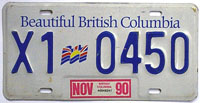 |
|||||||||||||||||||||
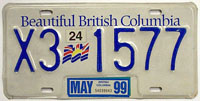 |
||||||||||||||||||||||
X4-xxxx Bloc
|
||||||||||||||||||||||
|
© Copyright Christopher John Garrish. All rights reserved.


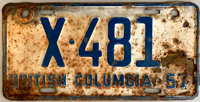

.jpg)
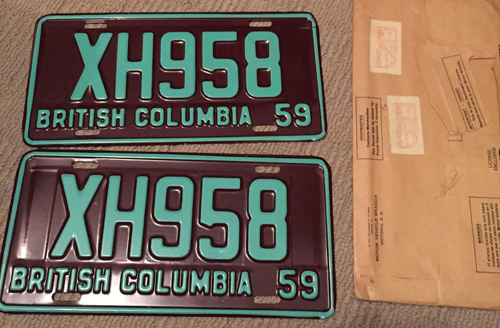
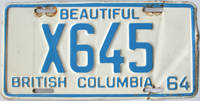

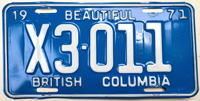




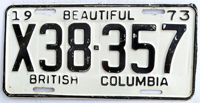
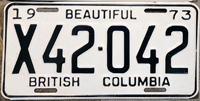








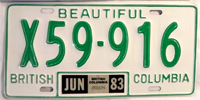


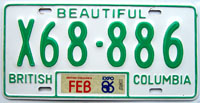
.jpg)
.jpg)
